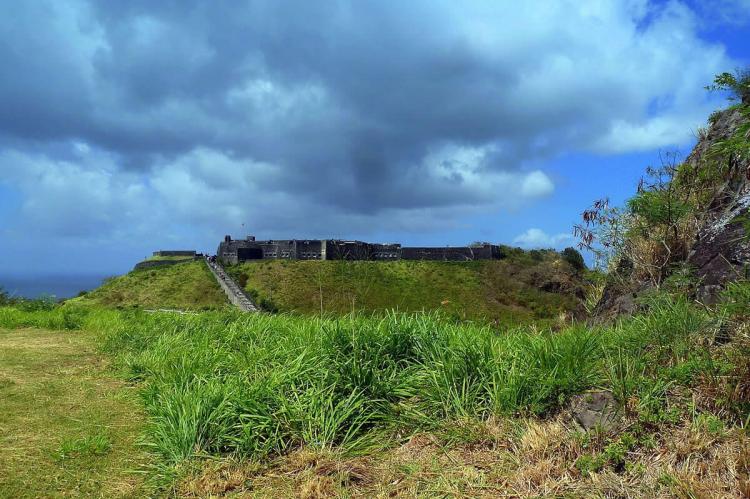Saint Mary's Biosphere Reserve: A Caribbean Haven of Biodiversity
Saint Mary's Biosphere Reserve in Saint Kitts and Nevis is a diverse ecosystem with cloud forests, mangroves, and coral reefs, home to a range of wildlife, maintaining ecological balance. The Brimstone Hill Fortress National Park is at the center, showcasing the island's resilience and architectural grandeur.
Saint Mary's Biosphere Reserve
A Caribbean Haven of Biodiversity
Nestled in the heart of Saint Kitts, the Saint Mary's Biosphere Reserve is a testament to the island's commitment to preserving its rich biological mosaic. This Caribbean gem, near the town of Cayon and the village of Keys, is a harmonious blend of diverse ecosystems, boasting cloud forests, mangroves, and coral reefs that paint a vibrant portrait of life. Here, nature's canvas extends from the forested ridges with their seasonal streams to the sandy beaches gently meeting the Atlantic Ocean.
Geological Mosaic
The geological heartbeat of Saint Kitts, characterized by andesite and dacite volcanic rocks, narrates a story of the island's tumultuous past. Within this captivating landscape lies the Brimstone Hill Fortress National Park, an architectural marvel that adds a historical and cultural layer to the biosphere reserve. The fortress, perched atop a volcanic hill, is a guardian of Saint Kitts' past, offering visitors a glimpse into the region's colonial struggles and triumphs.
Historical Significance
The Brimstone Hill Fortress National Park, an integral part of the biosphere reserve, unfolds as attestation to the complex medley of Caribbean history. Spanning approximately 15 hectares (37 acres) and surrounded by a 1.6-kilometer (1-mile) buffer zone, this meticulously preserved fortress is an exemplar of European colonial expansion and the African slave trade. It is a jewel in the crown of St. Kitts, offering visitors a glimpse into the struggles and triumphs that shaped the region.
Engineering Marvel and Colonial Battleground
The fortress, an intricate engineering marvel, was conceived by British designers and brought to life through the labor of enslaved Africans. Perched on a double-peaked volcanic hill rising 230 meters (755 feet) above sea level, the architects harnessed the natural topography to create a stronghold to safeguard the island's citizens and protect the coastline from potential Caribbean Sea threats.
St. Christopher (St. Kitts), the inaugural West Indies island to witness European colonization, became a battleground for supremacy between the French and English. Brimstone Hill's military saga began in 1690 when the British strategically placed a cannon to oust the French. Over the next century, the fortress evolved in response to the changing tides of power dynamics in the region, becoming a symbol of resilience and adaptability.
Architectural Splendor and Legacy
The fortress's principal structures, constructed in basalt blocks with a rubble core, are strategically positioned on different levels of the upper third of the hill. The use of local limestone for decorative elements adds a touch of elegance to the fortress, highlighting the craftsmanship of its builders. Quarries on the lower slopes provided the abundant stone necessary for construction.
Fort George, also known as the Citadel, is at the heart of Brimstone Hill. Completed in the late 1700s, it represents the earliest surviving example of the "Polygonal System" of fortress design. This strategic masterpiece showcases its architects' meticulous planning and foresight, providing a glimpse into the military prowess of the time.
Biodiversity and Conservation
The Saint Mary's Biosphere Reserve is a haven for diverse flora and a critical nesting ground for the leatherback sea turtle. As a species teetering on the brink of extinction, preserving this sandy nesting habitat becomes a poignant mission for the reserve. The biosphere reserve echoes with the nocturnal symphony of bats, the sole terrestrial mammals native to the region. The pig-faced bat, fishing bat, and Velvety House Bat find sanctuary amidst the lush foliage, contributing to the delicate balance of this ecological haven.
Avian Wonders and Marine Life
Avian wonders grace the skies, with the purple-throated carib and Antillean crested hummingbird adding splashes of color to the landscape. Beneath the ocean's surface, the lizardfish glides through the coral reefs, adding to the underwater spectacle that mirrors the diversity found on land.
Preserving the Spirit
Brimstone Hill Fortress served its purpose until 1853, when the British military, facing changing geopolitical realities, abandoned it and dismantled many of its structures. However, the fortress found a new lease on life as it became a national park, preserving the physical remnants and the spirit of resilience that defines the Caribbean.
In the embrace of Saint Mary's Biosphere Reserve, Saint Kitts celebrates not just a nature reserve but a commitment to conserving biodiversity, a celebration of the interconnected dance of life that defines this Caribbean paradise.




